Accounts Computations: FIFO, LIFO, and Merchandising Company Analysis
VerifiedAdded on 2023/04/21
|6
|826
|269
Homework Assignment
AI Summary
This assignment focuses on accounts computations, covering topics such as inventory costing methods (FIFO and LIFO), and the preparation of income statements for merchandising companies. It includes journal entries for merchandise purchases on credit, demonstrating how discounts are applied when payments are made within the specified credit terms. The assignment also explains the differences between merchandising and service companies, particularly in terms of inventory and cost of goods sold. A detailed income statement for Yazeed Merchandising Company is presented, illustrating the calculation of net sales, gross profit, and net operating income. Desklib provides students access to similar solved assignments and study tools.
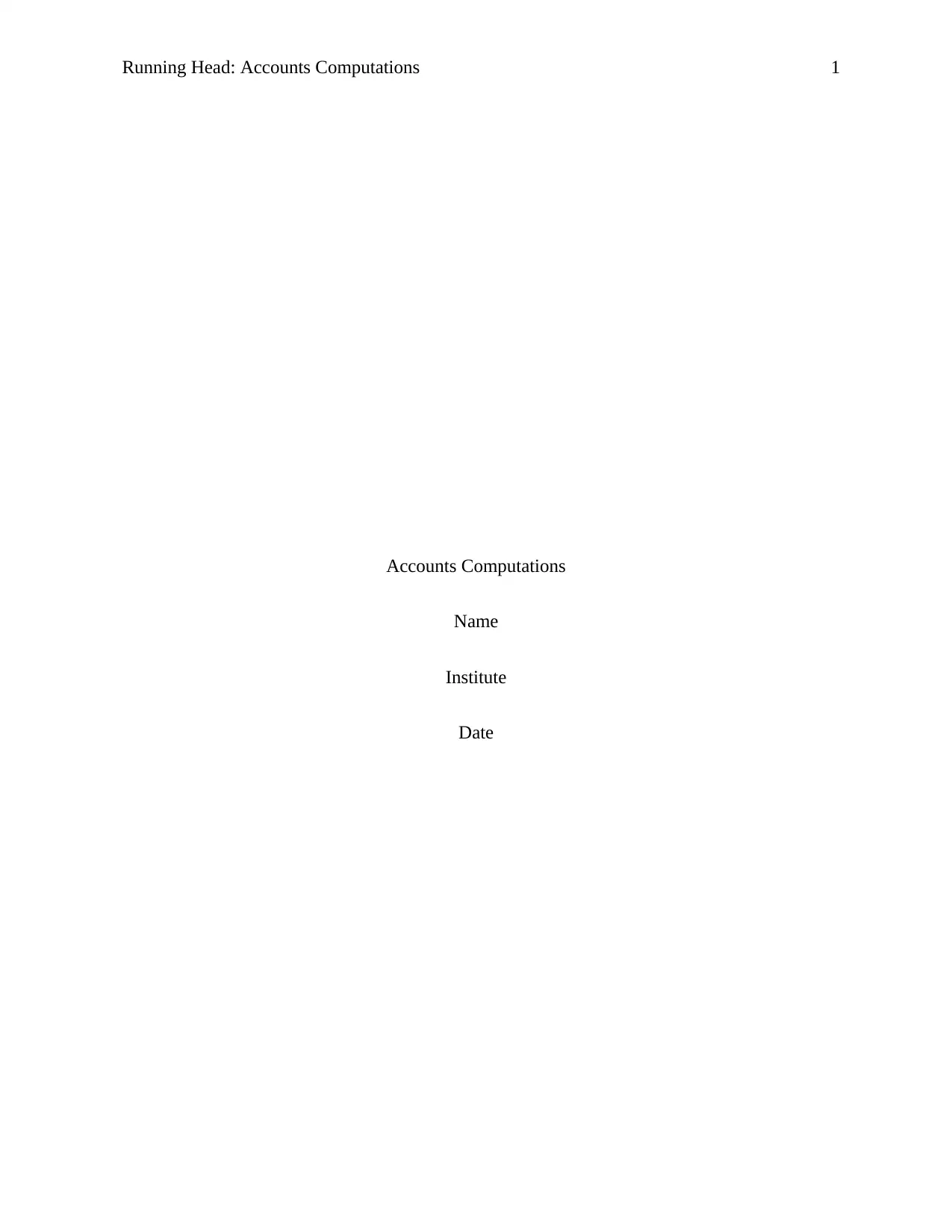
Running Head: Accounts Computations 1
Accounts Computations
Name
Institute
Date
Accounts Computations
Name
Institute
Date
Paraphrase This Document
Need a fresh take? Get an instant paraphrase of this document with our AI Paraphraser
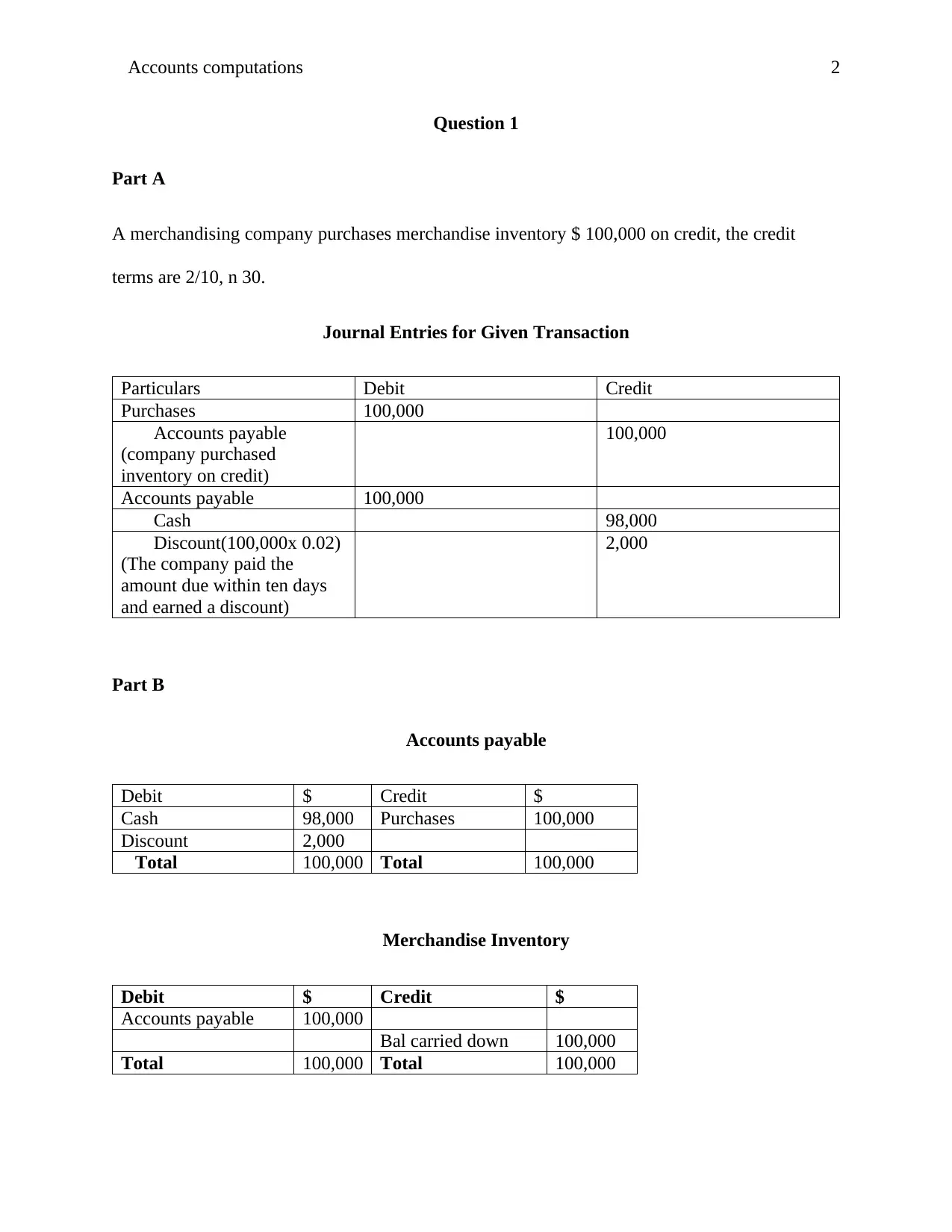
Accounts computations 2
Question 1
Part A
A merchandising company purchases merchandise inventory $ 100,000 on credit, the credit
terms are 2/10, n 30.
Journal Entries for Given Transaction
Particulars Debit Credit
Purchases 100,000
Accounts payable
(company purchased
inventory on credit)
100,000
Accounts payable 100,000
Cash 98,000
Discount(100,000x 0.02)
(The company paid the
amount due within ten days
and earned a discount)
2,000
Part B
Accounts payable
Debit $ Credit $
Cash 98,000 Purchases 100,000
Discount 2,000
Total 100,000 Total 100,000
Merchandise Inventory
Debit $ Credit $
Accounts payable 100,000
Bal carried down 100,000
Total 100,000 Total 100,000
Question 1
Part A
A merchandising company purchases merchandise inventory $ 100,000 on credit, the credit
terms are 2/10, n 30.
Journal Entries for Given Transaction
Particulars Debit Credit
Purchases 100,000
Accounts payable
(company purchased
inventory on credit)
100,000
Accounts payable 100,000
Cash 98,000
Discount(100,000x 0.02)
(The company paid the
amount due within ten days
and earned a discount)
2,000
Part B
Accounts payable
Debit $ Credit $
Cash 98,000 Purchases 100,000
Discount 2,000
Total 100,000 Total 100,000
Merchandise Inventory
Debit $ Credit $
Accounts payable 100,000
Bal carried down 100,000
Total 100,000 Total 100,000
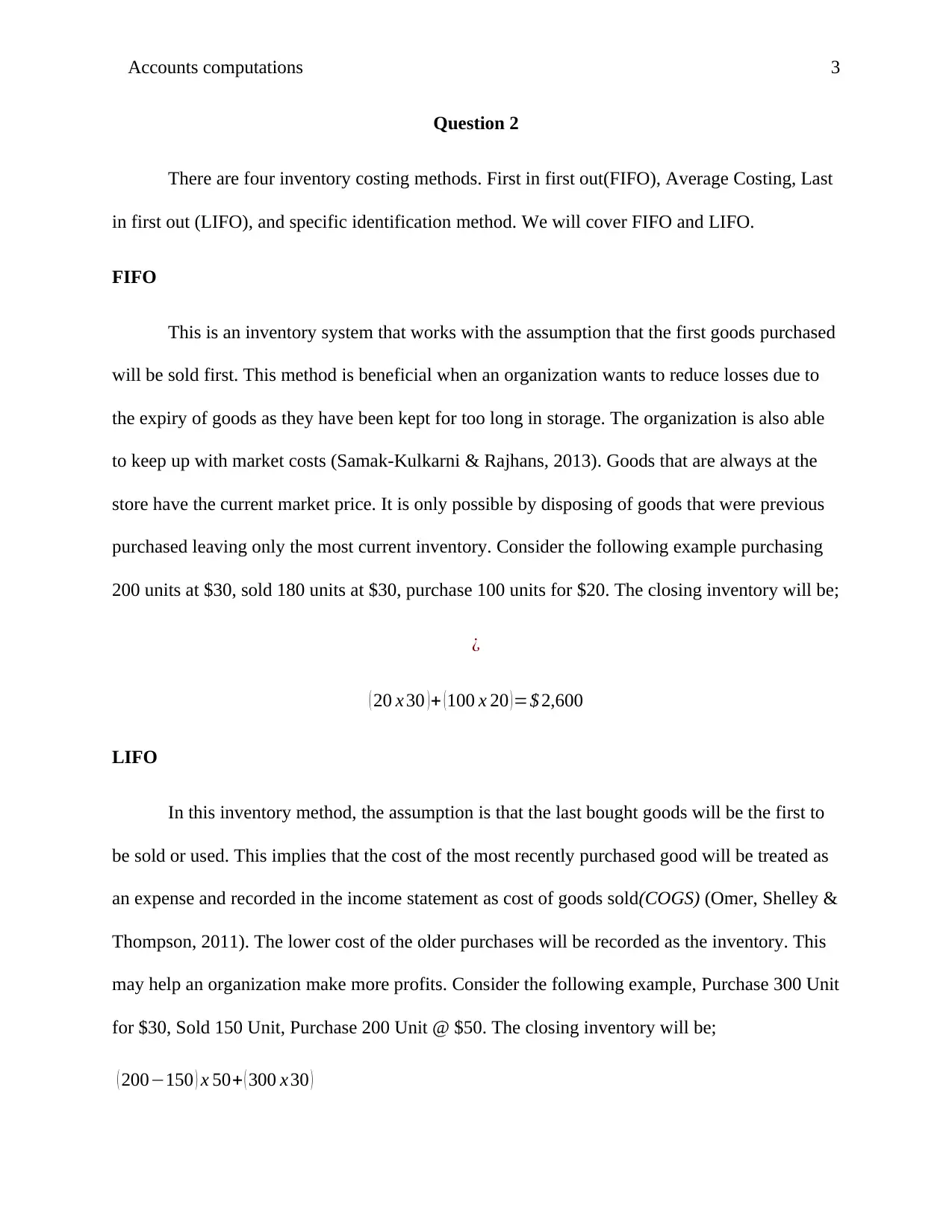
Accounts computations 3
Question 2
There are four inventory costing methods. First in first out(FIFO), Average Costing, Last
in first out (LIFO), and specific identification method. We will cover FIFO and LIFO.
FIFO
This is an inventory system that works with the assumption that the first goods purchased
will be sold first. This method is beneficial when an organization wants to reduce losses due to
the expiry of goods as they have been kept for too long in storage. The organization is also able
to keep up with market costs (Samak-Kulkarni & Rajhans, 2013). Goods that are always at the
store have the current market price. It is only possible by disposing of goods that were previous
purchased leaving only the most current inventory. Consider the following example purchasing
200 units at $30, sold 180 units at $30, purchase 100 units for $20. The closing inventory will be;
¿
( 20 x 30 ) + ( 100 x 20 ) =$ 2,600
LIFO
In this inventory method, the assumption is that the last bought goods will be the first to
be sold or used. This implies that the cost of the most recently purchased good will be treated as
an expense and recorded in the income statement as cost of goods sold(COGS) (Omer, Shelley &
Thompson, 2011). The lower cost of the older purchases will be recorded as the inventory. This
may help an organization make more profits. Consider the following example, Purchase 300 Unit
for $30, Sold 150 Unit, Purchase 200 Unit @ $50. The closing inventory will be;
( 200−150 ) x 50+ ( 300 x 30 )
Question 2
There are four inventory costing methods. First in first out(FIFO), Average Costing, Last
in first out (LIFO), and specific identification method. We will cover FIFO and LIFO.
FIFO
This is an inventory system that works with the assumption that the first goods purchased
will be sold first. This method is beneficial when an organization wants to reduce losses due to
the expiry of goods as they have been kept for too long in storage. The organization is also able
to keep up with market costs (Samak-Kulkarni & Rajhans, 2013). Goods that are always at the
store have the current market price. It is only possible by disposing of goods that were previous
purchased leaving only the most current inventory. Consider the following example purchasing
200 units at $30, sold 180 units at $30, purchase 100 units for $20. The closing inventory will be;
¿
( 20 x 30 ) + ( 100 x 20 ) =$ 2,600
LIFO
In this inventory method, the assumption is that the last bought goods will be the first to
be sold or used. This implies that the cost of the most recently purchased good will be treated as
an expense and recorded in the income statement as cost of goods sold(COGS) (Omer, Shelley &
Thompson, 2011). The lower cost of the older purchases will be recorded as the inventory. This
may help an organization make more profits. Consider the following example, Purchase 300 Unit
for $30, Sold 150 Unit, Purchase 200 Unit @ $50. The closing inventory will be;
( 200−150 ) x 50+ ( 300 x 30 )
⊘ This is a preview!⊘
Do you want full access?
Subscribe today to unlock all pages.

Trusted by 1+ million students worldwide
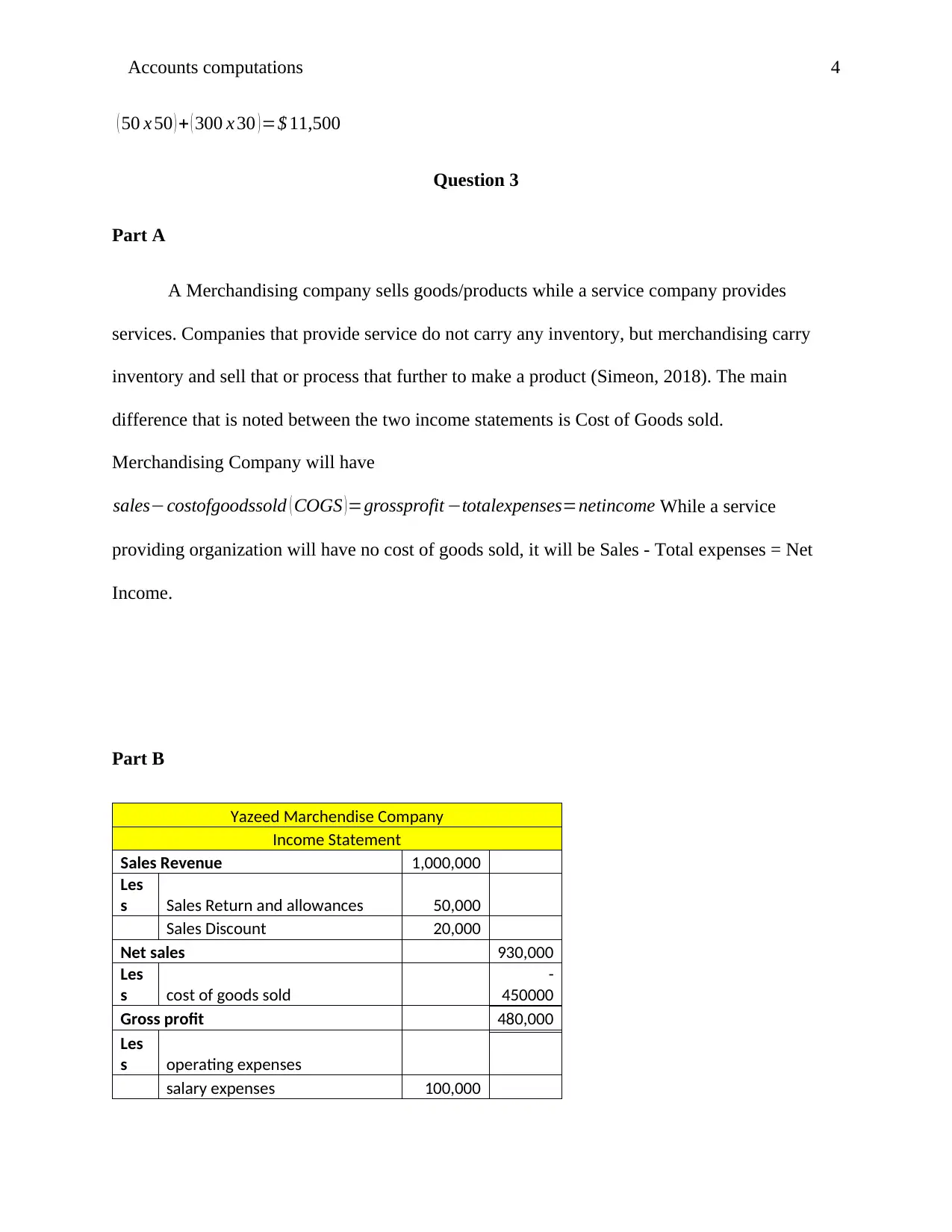
Accounts computations 4
( 50 x 50 ) + ( 300 x 30 )=$ 11,500
Question 3
Part A
A Merchandising company sells goods/products while a service company provides
services. Companies that provide service do not carry any inventory, but merchandising carry
inventory and sell that or process that further to make a product (Simeon, 2018). The main
difference that is noted between the two income statements is Cost of Goods sold.
Merchandising Company will have
sales−costofgoodssold ( COGS )=grossprofit −totalexpenses=netincome While a service
providing organization will have no cost of goods sold, it will be Sales - Total expenses = Net
Income.
Part B
Yazeed Marchendise Company
Income Statement
Sales Revenue 1,000,000
Les
s Sales Return and allowances 50,000
Sales Discount 20,000
Net sales 930,000
Les
s cost of goods sold
-
450000
Gross profit 480,000
Les
s operating expenses
salary expenses 100,000
( 50 x 50 ) + ( 300 x 30 )=$ 11,500
Question 3
Part A
A Merchandising company sells goods/products while a service company provides
services. Companies that provide service do not carry any inventory, but merchandising carry
inventory and sell that or process that further to make a product (Simeon, 2018). The main
difference that is noted between the two income statements is Cost of Goods sold.
Merchandising Company will have
sales−costofgoodssold ( COGS )=grossprofit −totalexpenses=netincome While a service
providing organization will have no cost of goods sold, it will be Sales - Total expenses = Net
Income.
Part B
Yazeed Marchendise Company
Income Statement
Sales Revenue 1,000,000
Les
s Sales Return and allowances 50,000
Sales Discount 20,000
Net sales 930,000
Les
s cost of goods sold
-
450000
Gross profit 480,000
Les
s operating expenses
salary expenses 100,000
Paraphrase This Document
Need a fresh take? Get an instant paraphrase of this document with our AI Paraphraser
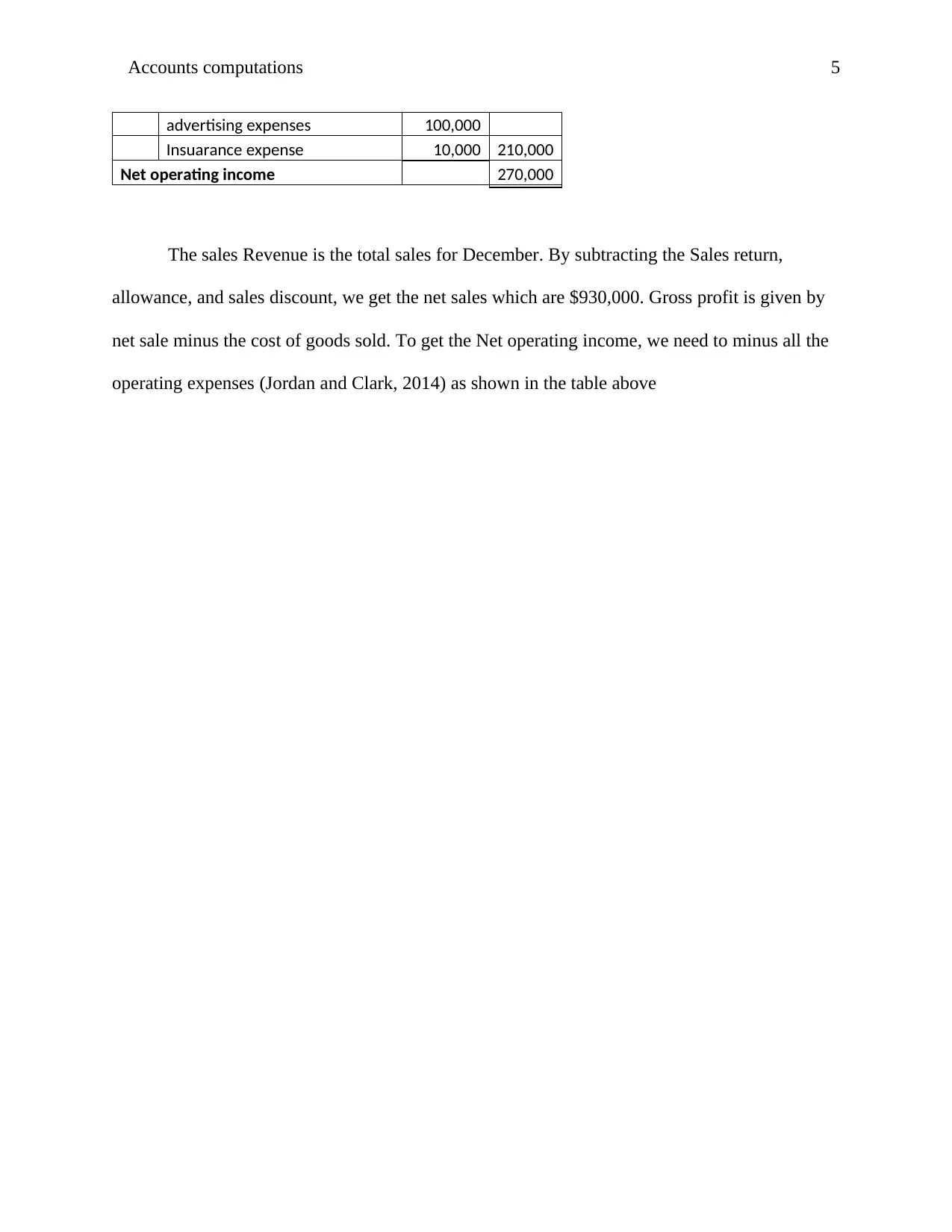
Accounts computations 5
advertising expenses 100,000
Insuarance expense 10,000 210,000
Net operating income 270,000
The sales Revenue is the total sales for December. By subtracting the Sales return,
allowance, and sales discount, we get the net sales which are $930,000. Gross profit is given by
net sale minus the cost of goods sold. To get the Net operating income, we need to minus all the
operating expenses (Jordan and Clark, 2014) as shown in the table above
advertising expenses 100,000
Insuarance expense 10,000 210,000
Net operating income 270,000
The sales Revenue is the total sales for December. By subtracting the Sales return,
allowance, and sales discount, we get the net sales which are $930,000. Gross profit is given by
net sale minus the cost of goods sold. To get the Net operating income, we need to minus all the
operating expenses (Jordan and Clark, 2014) as shown in the table above
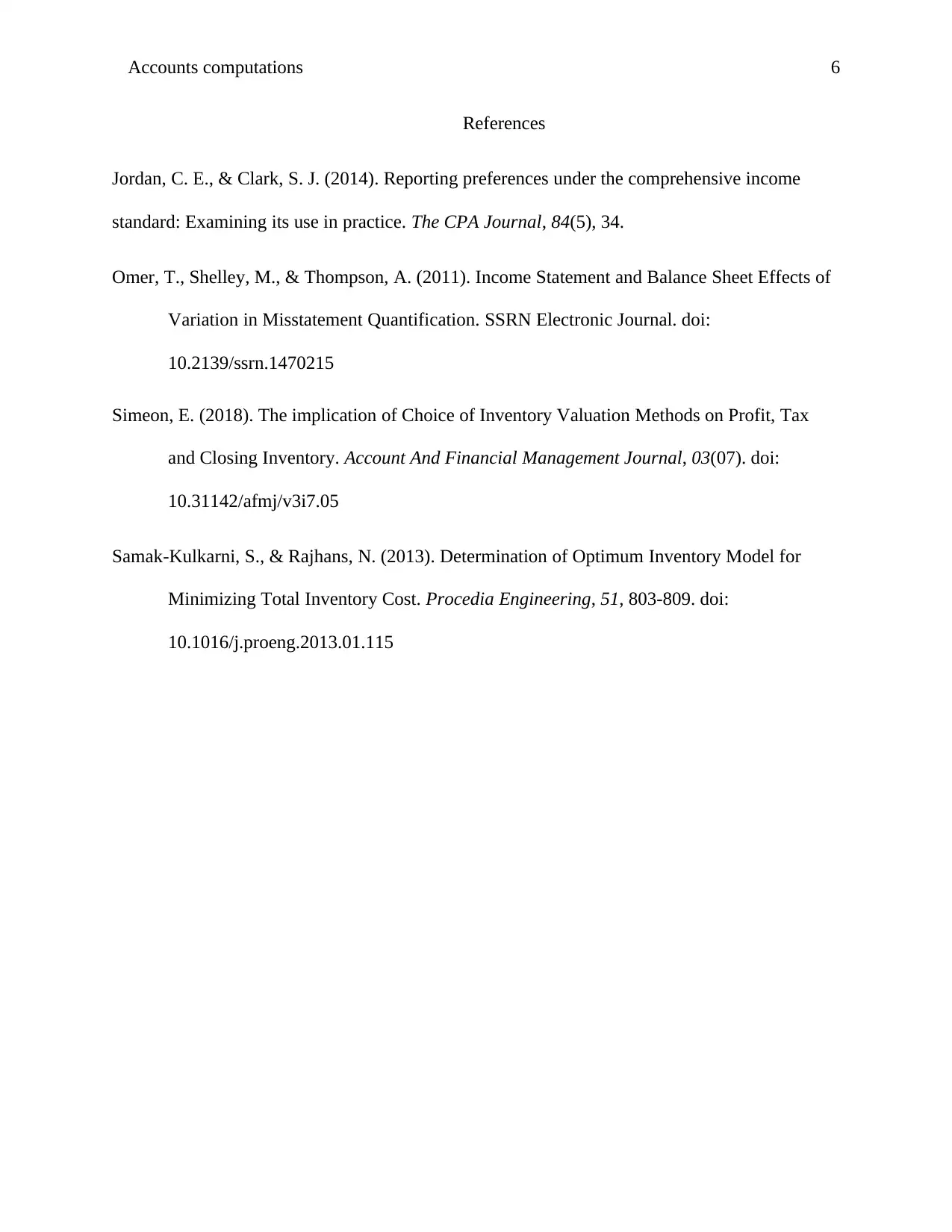
Accounts computations 6
References
Jordan, C. E., & Clark, S. J. (2014). Reporting preferences under the comprehensive income
standard: Examining its use in practice. The CPA Journal, 84(5), 34.
Omer, T., Shelley, M., & Thompson, A. (2011). Income Statement and Balance Sheet Effects of
Variation in Misstatement Quantification. SSRN Electronic Journal. doi:
10.2139/ssrn.1470215
Simeon, E. (2018). The implication of Choice of Inventory Valuation Methods on Profit, Tax
and Closing Inventory. Account And Financial Management Journal, 03(07). doi:
10.31142/afmj/v3i7.05
Samak-Kulkarni, S., & Rajhans, N. (2013). Determination of Optimum Inventory Model for
Minimizing Total Inventory Cost. Procedia Engineering, 51, 803-809. doi:
10.1016/j.proeng.2013.01.115
References
Jordan, C. E., & Clark, S. J. (2014). Reporting preferences under the comprehensive income
standard: Examining its use in practice. The CPA Journal, 84(5), 34.
Omer, T., Shelley, M., & Thompson, A. (2011). Income Statement and Balance Sheet Effects of
Variation in Misstatement Quantification. SSRN Electronic Journal. doi:
10.2139/ssrn.1470215
Simeon, E. (2018). The implication of Choice of Inventory Valuation Methods on Profit, Tax
and Closing Inventory. Account And Financial Management Journal, 03(07). doi:
10.31142/afmj/v3i7.05
Samak-Kulkarni, S., & Rajhans, N. (2013). Determination of Optimum Inventory Model for
Minimizing Total Inventory Cost. Procedia Engineering, 51, 803-809. doi:
10.1016/j.proeng.2013.01.115
⊘ This is a preview!⊘
Do you want full access?
Subscribe today to unlock all pages.

Trusted by 1+ million students worldwide
1 out of 6
Related Documents
Your All-in-One AI-Powered Toolkit for Academic Success.
+13062052269
info@desklib.com
Available 24*7 on WhatsApp / Email
![[object Object]](/_next/static/media/star-bottom.7253800d.svg)
Unlock your academic potential
Copyright © 2020–2025 A2Z Services. All Rights Reserved. Developed and managed by ZUCOL.





